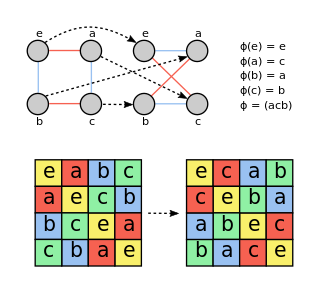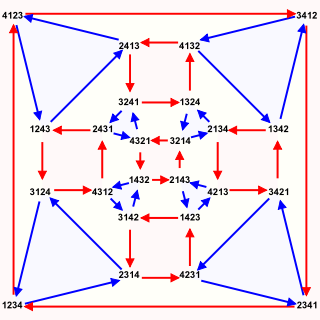
In mathematics, an automorphism is an isomorphism from a mathematical object to itself. It is, in some sense, a symmetry of the object, and a way of mapping the object to itself while preserving all of its structure. The set of all automorphisms of an object forms a group, called the automorphism group. It is, loosely speaking, the symmetry group of the object.

In mathematics, an abelian group, also called a commutative group, is a group in which the result of applying the group operation to two group elements does not depend on the order in which they are written. That is, the group operation is commutative. With addition as an operation, the integers and the real numbers form abelian groups, and the concept of an abelian group may be viewed as a generalization of these examples. Abelian groups are named after Niels Henrik Abel.

In the mathematical field of representation theory, group representations describe abstract groups in terms of bijective linear transformations of a vector space to itself ; in particular, they can be used to represent group elements as invertible matrices so that the group operation can be represented by matrix multiplication.

In mathematics, a Lie group is a group that is also a differentiable manifold, such that group multiplication and taking inverses are both differentiable.

In abstract algebra, the symmetric group defined over any set is the group whose elements are all the bijections from the set to itself, and whose group operation is the composition of functions. In particular, the finite symmetric group defined over a finite set of symbols consists of the permutations that can be performed on the symbols. Since there are such permutation operations, the order of the symmetric group is .

In abstract algebra, group theory studies the algebraic structures known as groups. The concept of a group is central to abstract algebra: other well-known algebraic structures, such as rings, fields, and vector spaces, can all be seen as groups endowed with additional operations and axioms. Groups recur throughout mathematics, and the methods of group theory have influenced many parts of algebra. Linear algebraic groups and Lie groups are two branches of group theory that have experienced advances and have become subject areas in their own right.

In mathematics, a simple group is a nontrivial group whose only normal subgroups are the trivial group and the group itself. A group that is not simple can be broken into two smaller groups, namely a nontrivial normal subgroup and the corresponding quotient group. This process can be repeated, and for finite groups one eventually arrives at uniquely determined simple groups, by the Jordan–Hölder theorem.

In mathematics, an alternating group is the group of even permutations of a finite set. The alternating group on a set of n elements is called the alternating group of degree n, or the alternating group on n letters and denoted by An or Alt(n).

In abstract algebra, a finite group is a group whose underlying set is finite. Finite groups often arise when considering symmetry of mathematical or physical objects, when those objects admit just a finite number of structure-preserving transformations. Important examples of finite groups include cyclic groups and permutation groups.
In mathematics, a group extension is a general means of describing a group in terms of a particular normal subgroup and quotient group. If and are two groups, then is an extension of by if there is a short exact sequence
In mathematics, Schur's lemma is an elementary but extremely useful statement in representation theory of groups and algebras. In the group case it says that if M and N are two finite-dimensional irreducible representations of a group G and φ is a linear map from M to N that commutes with the action of the group, then either φ is invertible, or φ = 0. An important special case occurs when M = N, i.e. φ is a self-map; in particular, any element of the center of a group must act as a scalar operator on M. The lemma is named after Issai Schur who used it to prove the Schur orthogonality relations and develop the basics of the representation theory of finite groups. Schur's lemma admits generalisations to Lie groups and Lie algebras, the most common of which are due to Jacques Dixmier and Daniel Quillen.

In mathematics, a reductive group is a type of linear algebraic group over a field. One definition is that a connected linear algebraic group G over a perfect field is reductive if it has a representation that has a finite kernel and is a direct sum of irreducible representations. Reductive groups include some of the most important groups in mathematics, such as the general linear group GL(n) of invertible matrices, the special orthogonal group SO(n), and the symplectic group Sp(2n). Simple algebraic groups and (more generally) semisimple algebraic groups are reductive.

In mathematical group theory, the Schur multiplier or Schur multiplicator is the second homology group of a group G. It was introduced by Issai Schur in his work on projective representations.

In mathematics, a Frobenius group is a transitive permutation group on a finite set, such that no non-trivial element fixes more than one point and some non-trivial element fixes a point. They are named after F. G. Frobenius.

In mathematics, specifically group theory, a Hall subgroup of a finite group G is a subgroup whose order is coprime to its index. They were introduced by the group theorist Philip Hall.
In mathematics, a matrix group is a group G consisting of invertible matrices over a specified field K, with the operation of matrix multiplication. A linear group is a group that is isomorphic to a matrix group.

Otto Schreier was a Jewish-Austrian mathematician who made major contributions in combinatorial group theory and in the topology of Lie groups.
The Schur–Zassenhaus theorem is a theorem in group theory which states that if is a finite group, and is a normal subgroup whose order is coprime to the order of the quotient group , then is a semidirect product of and . An alternative statement of the theorem is that any normal Hall subgroup of a finite group has a complement in . Moreover if either or is solvable then the Schur–Zassenhaus theorem also states that all complements of in are conjugate. The assumption that either or is solvable can be dropped as it is always satisfied, but all known proofs of this require the use of the much harder Feit–Thompson theorem.
The history of group theory, a mathematical domain studying groups in their various forms, has evolved in various parallel threads. There are three historical roots of group theory: the theory of algebraic equations, number theory and geometry. Joseph Louis Lagrange, Niels Henrik Abel and Évariste Galois were early researchers in the field of group theory.







